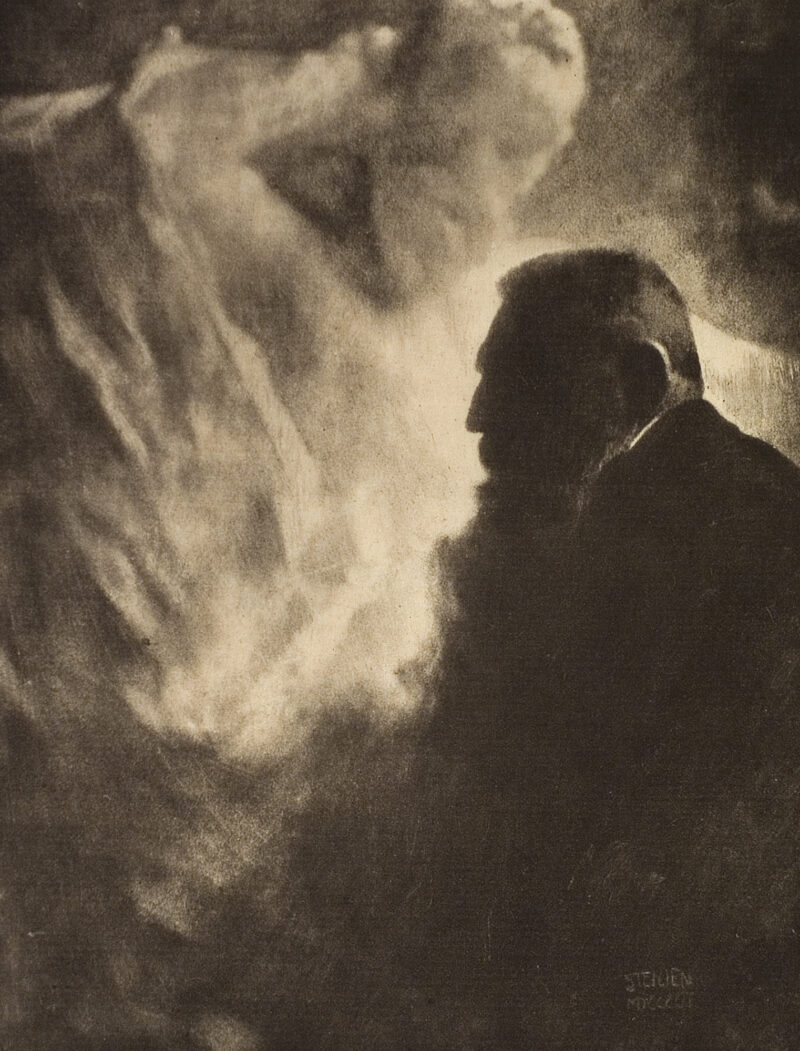
Rodin—The Thinker
Steichen, Edward
1903, April
Artwork Information
-
Title:
Rodin—The Thinker
-
Artist:
Steichen, Edward
-
Artist Bio:
American (born in Luxembourg), 1879–1973
-
Date:
1903, April
-
Medium:
Photogravure
-
Dimensions:
8 1/8 x 6 3/8 inches
-
Credit Line:
Wichita Art Museum, Gift of Donna R. Bailey and Cornelia R. Yohr in memory of Grace Voss Ripley
-
Object Number:
2007.29.12
-
Display:
Not Currently on Display
About the Artwork
The photogravure is the earliest photographic technique, predating even the daguerreotype. Strictly speaking, it is a cross between a photograph and a print, since the first step is taken with a camera. After fixing an image, a positive is made from the original negative. The positive is then placed on a sheet of tissue paper that has been treated with pigmented gelatin and exposed to ultraviolet light. Separately, a copper plate is prepared just as one would an aquatint plate. The exposed tissue and the copper plate are sandwiched together, then placed in an acid bath. After repeated immersions in the acid, the plate is inked and run through a printing press to obtain the final print. The degree of darkness in any area depends upon both the degree to which the tissue was exposed to light and the length and number of immersions of the plate in acid. Artists continue to work in this complicated process because of the advantage is has over almost any other: extraordinary tonal range. The nuance of grey scale in a photogravure can result in a subtlety or drama virtually unmatched by other printing processes.
The artist who took the photogravure to its height of expressive potential was Alfred Stieglitz (1864–1946). After studying photography in Berlin in the 1890s, Stieglitz returned to New York determined to transform photography in America from a hobby practiced by amateurs to an independent art form on a par with the other fine arts. With that goal in mind, he founded the serial publication Camera Work in 1903. The artist-photographers Stieglitz represented in Camera Work had in common a preference for soft-focus work that was highly atmospheric. This, they thought, was their equivalent of a painter’s painterliness.
One of the first artists Stieglitz included in Camera Work was Edward Steichen (1879–1973), who had recently returned from two years of study in France. Steichen’s first contribution to Camera Work was a version of the photographic montage titled Rodin—The Thinker that he had made in Paris the previous year. It showed Auguste Rodin in profile, facing his bronze figure The Thinker, with his marble sculpture of Victor Hugo in the background. Rodin confronts the Michelangelo like Thinker like a great chess player. Steichen’s soft focus and tonal gradation allow forms to blend in and out of each other, evocative of an otherworldly dream vision. Victor Hugo looks down like a ghost or a muse, defying or inspiring its maker.
When Steichen arrived in Paris in 1900 the artist, he wanted to meet above all others was Rodin, considered one of the greatest living artists and admired particularly by Steichen for his monumental scale and powerful expression. A mutual friend provided the introduction, at which the young photographer showed the master his portfolio. Rodin was so impressed that he invited Steichen to visit him any and every Sunday he pleased. After a year of visits, Steichen created Rodin—The Thinker. Steichen’s second wife wrote that it was the only one of his photographs that he wanted to be displayed in their house. The Rodin published in Camera Works cropped off the right half of Rodin—The Thinker. And because of the use of a positive in the photogravure process, reversed the image and brought Victor Hugo and Rodin closer to the picture plane. The greater modulation of tones resulting from the photogravure process creates an even more mystical relationship between the two figures. Steichen’s Rodin is so evocative that it stands for–even symbolizes–fin-de-siиcle French culture. Ironically, its artist was a young man from Milwaukee.